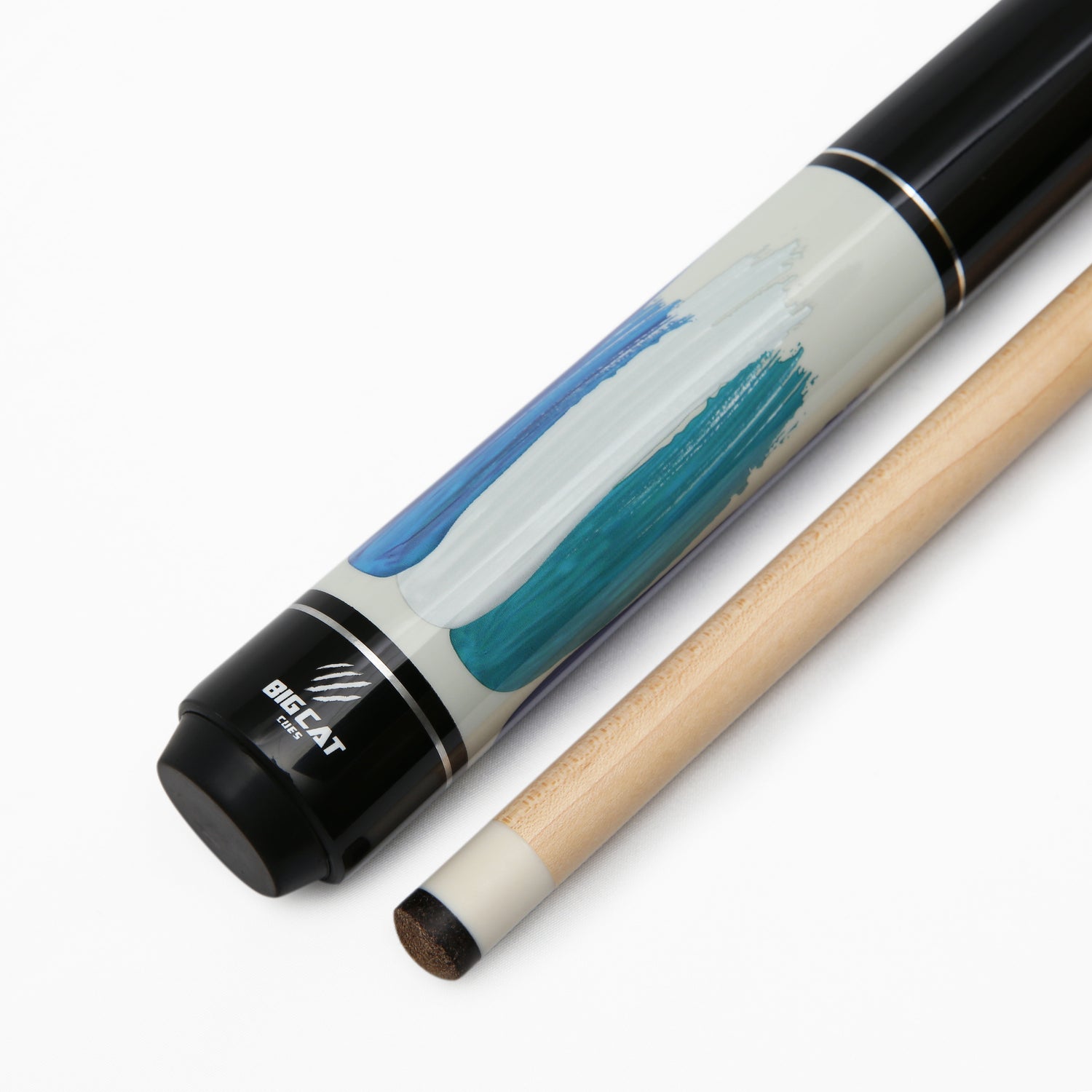
Rules of Pool Game: 10 Pool Game Rules You Should Know
What are the basic rules of the pool game? If you are stepping into the pool hall for the first time, this guide is what you need. We'll dive into the ins and outs of various pool games, uncovering the rules that shape the experience.
Each game has unique challenges and strategies, from the classic 8-ball to the modern One-pocket. Let's ‘cue up’ the knowledge and start your pool journey on the right stroke.
8-Ball Pool Rules
8 ball pool is a superior game, a classic but legendary entertainment to countless people. To start, let's talk about the rules that govern this widely played game variation.
What are the rules for the 8-ball pool table game? This game's origin is 15 object balls, including solid and striped groups, with the elusive black 8-ball holding the key to victory.
One player aims to pocket the balls numbered 1 through 7 (solid colors), while their opponent focuses on the balls numbered 9 through 15 (stripes). The final win in the game goes to the player who shoots the 8-ball after legally sinking their group of balls.
The Setup:
- The game begins with an exact arrangement of the object balls in the triangle rack at the lower end of the table.
- The black 8-ball takes place in the middle of the third row, surrounded by a random distribution of the other balls.
For further instruction, check out Big Cat's guide on racking pool balls.
Break and Group Assignment:
- Strike the balls to start the game.
- The player pocketing the first ball post-break defines their group (solids or stripes).
Legal Break:
- Perform the break, ensuring the cue ball avoids pockets.
- Four balls must touch the cushions.
- You can request a re-rack after pocketing the 8-ball during the break.
Game Process:
- The player pots balls from their assigned group.
- The opponent targets the other group.
- Alternate turns continue until a foul or a missed shot.
Turns:
- Each player must pot their assigned balls before aiming for the 8-ball.
- Decide the pocket for the 8-ball before the shot.
- Failure grants the opposing player a chance.
Winning the Game:
- The game ends when players legally pocket the 8-ball after potting their assigned group.
- Placing the 8-ball in an incorrect pocket results in a loss.
Remember, this game is a mix of strategy and skill. Master the basic pool rules, choose your groups wisely, and sink the 8-ball to win this classic and widely enjoyed game.
9-Ball Pool Rules

9-Ball Pool (Image Source: WikiHow)
Compared to 8-ball pool rules, the 9-ball pool requires a more strategic understanding of numerical progression. With 10 numbered balls and a white cue ball, the objective is clear: pocket the 9-ball and win.
Setup:
- Arrange the balls in a diamond-shaped rack with the 1-ball at the top and the nine-ball in the center.
- Place the cue ball behind the headstring.
Break and Initial Conditions:
- The breaker starts with the 1-ball, aiming to pocket a ball or move at least four numbered balls to the rail.
- Foul conditions include driving off the table, pocketing the cue ball, or failing to meet initial break conditions.
Game Process:
- The breaker continues shooting until a miss, foul, or winning the match by legally pocketing one or more balls on a legal break.
- The other player starts their inning and continues until a miss, foul, or victory if the first player fouls or misses.
Winning the Game:
- The game finishes when a player legally pockets the nine ball on a legal shot.
- Major rule violations result in forfeiting the game.
Note: Unlike 8-ball pool billiards rules, the focus in 9-ball is on pocketing balls in numerical order, with the ultimate goal of sinking the 9-ball to win. So, grab your pool cue and enjoy this dynamic and strategic game.
10 Ball Pool Rules

10-ball pool (Image Source: Shutterstock)
10-Ball has a strategic detail with called shots, emphasizing player precision. The game also combines skill and strategy, providing an engaging pool experience.
Setup:
Arrange the 10-ball rack in a triangle, with the 1-ball at the front and the 10-ball in the middle. Randomly place the remaining balls.
Shot Selection:
- Always aim for the lowest-numbered ball first.
- Before each shot, declare which ball will go into which pocket.
Game Process:
- Successfully pocketing the called object ball into the named pocket allows for a continued turn.
- The game moves to the second player if the first one doesn't meet the condition.
Restrictions:
- It's unacceptable to pocket the 10-ball during the sequence.
- Players must call each strike and call only one ball per shot.
- No slop is allowed, emphasizing precise shot selection.
Re-Spotting:
- If a player pocketes the 10-ball while other balls are on the table, it is re-spotted.
- Rack the ball in the foot position before the next shot.
Winning the Game: The victor is the player who accurately pockets the last ball on the table, the 10-ball, into the named pocket.
15-Ball Pool Rules

15-Ball Pool (Image Source: Youtube)
In the 1800s, the 15-ball pool is a renowned American pocket billiards game. Back then, many enthusiasts gathered in the Manhattan-based Bassford's Billiard & Chess Rooms to craft this game. Now, let's break down the basic pool rules of this classic game.
Setup:
- You will play on a unique 6-pocket table.
- 15 numbered balls are racked up in a triangle shape at the beginning.
- The 15-ball starts at the front, near your feet. The other high-numbered balls are behind it, while the rest are in the back rows.
Game Process:
- Every time you successfully pocket a ball, you earn points based on the number on that ball. The goal is to get as many points as possible.
- If there are more than two players, the game changes slightly. The aim is to score the most points or be the first to reach 61 points or more to win a round.
Tournament Play: You might still lose a round even if you sink twice as many balls as the winner. It's about quality, not just quantity.
Violations:
- Be careful not to break the rules. You lose points if you do something against the rules (a violation).
- Each violation takes away 3 points. You lose the entire round if you keep breaking the rules three times in a row.
Bumper Pool Rules

Octagonal table for Bumper pool (Image Source: Zing Patio)
The bumper pool, a unique and lively twist in billiards, features a rectangular or occasionally octagonal table with two pockets and an array of fixed bumpers. According to the Billiard World Magazine, here are some rules of pool games that create dynamic and strategic matches:
Setup:
- You need a special table with only two pockets, not your usual rectangular one but sometimes octagonal.
- Inside this arena, the surface features fixed cushioned barriers called bumpers.
Group Assignment:
- There are 5 red balls and five white balls on each side.
- Each player gets a marked cue ball of a specific color. The red and white balls are strategically placed around the pockets in a specific arrangement.
Game Process:
- Both players shoot their marked balls, aiming to bank them into or close to their color cup after hitting the side cushion.
- The player who has their ball closest to or into their cup earns another shot.
- If someone sinks another ball before their opponent pockets their marked ball, the opponent can withdraw two of their balls and put them in their cup.
- If a player successfully pockets both marked balls on the first shot, they continue the streak with the remaining balls.
Winning the Game: The first player to sink all five balls wins.
Straight Pool Rules
Straight Pool, a game of precision and strategy, brings a different dimension to the pool world with its unique rules.
Setup: The stage includes a white cue ball and 15 object balls numbered 1-15. The game starts with a rack in a triangle shape and the cue ball positioned behind the head string.
Break and Initial Conditions:
- The opening break requires the cue ball to contact any ball first.
- To avoid a foul, the cue ball and at least two additional balls must touch the rail, or a ball must be pocketed during the break. Failing to achieve either results in a foul, with a unique penalty of a loss of 2 points.
Game Process:
- The shooter remains at the table as long as they successfully shoot called balls or until they earn the required points to win the game.
- Each successful pocketed ball without a foul adds one point to the player's score.
Restrictions:
- It is a foul if no ball hits the rail after contact or a shot extends beyond 60 seconds. Each foul results in a deduction of one point, swiftly shifting the turn to the opponent.
- A player facing three successive fouls faces an extra penalty—losing 15 points. The game then resets with a re-racked set of balls.
Winning the Game: You win once you earn a specific quantity of points, typically 15 by default.
Cutthroat Pool Rules

Cutthroat Pool rules (Image Source: wikiHow)
The cutthroat pool is a dynamic variant designed for three or more players. The rules of pool are about standing last, utilizing your pool cue, and ensuring your balls remain on the table.
Setup:
This game requires a standard pool table with 15 object balls, numbered 1 to 15, and the familiar cue ball.
Game Process:
- As the game begins, each player chooses a number representing the group of balls under control.
- The game takes a competitive turn as players aim not only for their balls but also strategically target their opponents' spheres.
- When you successfully pocket a ball belonging to your opponent, you can keep shooting until you miss or make an unlawful shot. The more balls you hit, the more options you have for future strikes.
Elimination:
- Players face elimination when they successfully pocket all their assigned balls.
- However, the twist lies in that if your opponent commits a foul, you get a lifeline - a chance to go back to the game.
Winning the Game: The player left with any balls still on the table is the winner.
Bank Pool Rules
Bank Pool revolves around scoring points through skillful bank shots. The pool billiards rules are simple: score more points than your opponents by exclusively making legal bank shots.
Setup: The game begins with all object balls racked tightly, with the head ball placed near the foot spot.
Break:
- The winner of the previous rack can break in the next round.
- The breaker can continue their round if they pocket object balls during the break, with the score counting for spotting in the following round.
- If the breaker fails to fulfill legal breaking standards, the opposing player may choose to start play where the balls are or demand a re-break.
Game Process:
- Each player takes turns shooting any object ball into any pocket, but only legal bank shots contribute to the score.
- Before each shot, the player must communicate the called ball, the planned cushion's path, and the intended pocket. If the called ball reaches the pocket through a different route, it doesn't count, and the player spots it without penalty.
- Every shot must be clean without running into other balls on the way to the called pocket.
- Successfully pocketing the called bank shot allows the player to continue their round.
- Players can pocket only one ball per shot, and any additional balls pocketed during the same stroke are set aside for spotting after the shooter's inning.
Special Considerations:
- Combination and carom shots are forbidden; the cue ball must first contact the called ball. On its path to the pocket, the cue ball can make only one contact with the object ball.
- Any ball shot on a double kiss is spotted without extra consequences, and the player's round ends.
Winning the Game: The first team or player to reach the necessary winning count claims victory.
One-Pocket Rules

Playing one-pocket (Image Source: Youtube)
If you are a beginner and want to learn to play pool, try the one-pocket pool. It is a compelling game tailored for two individuals or teams. This unique challenge is where each player aims to score exclusively into one of the two corner pockets at the foot of the table.
Setup: Each player or team selects a corner pocket at the foot of the table as their scoring zone.
Break and Foul Rules:
- The break begins with the cue ball behind the head string.
- To avoid a one-ball foul penalty, the cue ball or at least one object ball must touch a rail or be pocketed after contacting the rack.
- If a pocket scratch occurs, the incoming player gets the ball in hand, and they must play the balls as they lie, executing legal strokes from beneath the headstring.
Game Process:
- A player's round continues if they legally pocket balls in their selected pocket without committing a foul.
- While you can pocket a ball in the opponent's or a neutral pocket, it doesn't extend your round unless you concurrently pocket a ball in your pocket.
- Balls in the opponent's pocket benefit the opponent unless the cue ball is shot or falls off the table during the same stroke.
Winning the Game:
- The goal is to be the first to pocket eight balls into your designated corner pocket successfully.
- You win after pocketing both your and the opponent's game-winning ball on the same legal stroke.
- Ties are impossible, and the order in which the balls drop doesn't matter as long as both fall due to the same stroke.
Pool Scratch Rules
The rules of pool game are incomplete without mentioning scratching. Scratching happens when the cue ball takes an unexpected dip into the pocket or goes off the table after a shot. The aftermath of a scratch depends on the specifics of the foul action, usually resulting in the opponent gaining control of the table or getting the cue ball behind the headstrings.
In the game of 8-ball, scratching while going for that 8-ball is a no-go. If a player sinks the cue ball and the 8-ball in one shot, it's game over. However, if only the cue ball sinks, the opponent gets a ball in hand.
Various Shades of Scratches:
- Gameplay scratches occur during regular play, giving the opponent immediate control.
- Break scratches are a misstep during the break; hands over control to the opponent. In certain rule sets, it's a game forfeit.
- Table scratches commonly occur in everyday pool play when no ball is pocketed or when a ball bounces off the table.
Beyond the basics, scratching has its subtleties. Pockets filled with object balls alongside the cue ball scratch don't count; the cue ball gets a second chance on the table.
And that's our answer to your question: "How do you play the game of pool?". For more valuable guidelines, stay tuned with us at Big Cat. We will reveal all you need to know about pool cue, as well as provide the best tools, such as Paint Brush Line, Pearson Elite Series, Timeless Legacy Cues, and more. Elevate your gameplay—browse now!
Frequently Asked Questions
What are the rules for 2 shots in the pool?
In English 8-ball and blackball pool, the 2-shot rule applies after your opponent commits a foul. Following a foul, you receive two consecutive shots, which carry over (even if a ball is potted on the first shot). You can pick up the white ball with two shots and place it anywhere behind the line.
Is it legal to shoot backward in the pool?
Yes, it is legal to shoot the ball in any direction, including backward, as long as the cue ball is not behind the string. However, you must follow all criteria for a fair shot. The direction of the shot is irrelevant as long as it meets the rules for fair play.
The Bottom Line
The rules of pool games are diverse, from the strategic battles of one-pocket to the finesse of bank shots. Whether you're a seasoned player or a newcomer, pool embodies art and science. So, set up those balls, align your shot precisely, and win the game!
See more related articles:


